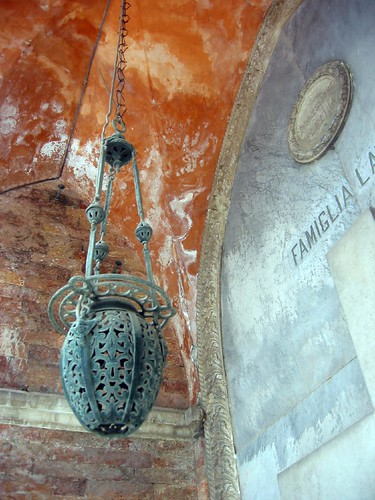
{Photo by rocketlass.}
In Willa Cather's pleasantly creepy little story "Consequences" (1915), a couple of characters--one of them haunted by an invasive, Walter Huston-esque apparition--get to discussing suicide. The unhaunted man describes the self-imposed end of a gentleman he knew:
Well, one afternoon when the tea was brought, he took prussic acid instead. He didn't leave any letters, either; people of any taste don't. They wouldn't leave any material reminder if they could help it.Good breeding, in other words, demands as little muss, mess, and fuss from our ends as possible--which would surely make leaving any sort of ghostly residue unspeakably gauche.
That desire for complete dissolution returned to my mind a few days later, as I read the chapter on "Fame and the Afterlife" in Keith Thomas's fascinating new book The Ends of Life: Roads to Fulfilment in Early Modern England (2009). In the course of charting the varieties and degrees of belief in various aspects of the afterlife in England in the years after the Reformation, Thomas notes,
[S]cepticism, implicit or explicity, about the literal reality of a future life, whether in heaven or in hell, was more widely dispersed than the clergy would have liked. The resurrection of the body had never been an easy doctrine to justify to an agricultural population who knew only too well waht happened to corpses, whether of men or animals.At the same time, the more one reads about the period, the more one understands the power of the desire to be reunited with lost loved ones, the
increasing tendency to hold out to breaved families the prospect of being reunited in the next world.A person fortunate enough to live to adulthood in those years would have been positively surrounded by the memories of dead siblings, parents, friends, and spouses; the idea of a place where all would be reunited--in, as Catherine Talbot put it, "a permanent state of felicity"--would have been undeniably attractive.
Thomas goes on to detail changes in funerary and memorial practices in the period, and in doing so he points out yet another reason why an early modern Englishman might have had doubts about the efficacy--or certainly the attractiveness--of actual physical resurrection: the "remarkably casual" attitude towards remains that prevailed. Writes Thomas, in his inimitably quote-driven style,
After a few years, the graves might be cleared, the gravestones sold, and the brasses reused to commemorate someone else. . . . Overcrowded graveyards were periodically cleared, the stones removed, and the graves reused. The Northampton physician James Hart noticed that graves were often dug for new guests before the bodies of the previous occupants had decayed. Even the bones of the dead, which in medieval times were customarily lifted and preserved in charnel houses, ceased to be the object of specific attention. "Gravestones tell truth scarce forty years," thought Sir Thomas Browne. "Our bones in consecrated ground never lie quiet," agreed John Aubrey, "and in London once in ten years (or thereabout) the earth is carried to the dung-wharf."All of which led me back to an old favorite, D. J. Enright's Oxford Book of Death (1983), which offers this wry take on the problem from Christina Rossetti's Time Flies (1897):
I well remember how one no longer present with us, but to whom I cease not to look up, shrank from entering the Mummy Room at the British Museum under a vivid realization of how the general resurrection might occur even as one stood among those solemn corpses turned into a sight for sightseers.Clearly, for those at both ends of the soul's spectrum--the ones with consciences clear enough to leave them confident of resurrection, and those who've left such marks as to be liable to ghostly expiation--cremation is the best, safest option.
And at that great and awful day, what will be thought of suppositious heads and members?
There is a well-known patch of the Episcopalian cemetery in Stockbridge, Massachusetts, where all the graves of a prominent family are arranged in a ring, all facing inward. That's so that, at the Resurrection, when they all come forht, they'll be facing members of their own family, and not random others who migh have been buried there over the centuries.
ReplyDeleteпорно видео онлайн учительницы http://free-3x.com/ трахнули училку фото и видио free-3x.com/ онлайн порно студенточек [url=http://free-3x.com/]free-3x.com[/url]
ReplyDelete